Sourdough Potato Bread
Sourdough Potato Bread has great flavour, a moist, open crumb, and a wonderfully chewy crust.
Inspired by an Italian recipe, I make it with my easy no-knead, overnight method which produces a sensational loaf of bread.
Wonderful eaten just as it is, spread with butter, in robust sandwiches, to accompany soups or with antipasti.
Jump to Recipe
Over the years, I’ve made a number of different potato breads.
While none of them end up tasting of potato, which isn’t the goal anyway, working grated or mashed potato into the dough certainly adds depth of flavour.
It’s also said to make the bread moister and keep it fresher for longer.
But of all the potato breads I’ve made, this Sourdough Potato Bread is by far the very best.
Real Bread
I was prompted to make a sourdough version of potato bread when I received my copy of Slow Dough: Real Bread (Nourish Books, 2016).
The author is Chris Young who’s coordinator of the Real Bread Campaign. The Campaign’s mission is to “find and share ways to make bread better for us, better for our communities and better for the planet”.
It’s a beautiful book with almost one hundred bread recipes many, but not all, using sourdough starter.
It also has lots of useful information on techniques, equipment and ingredients as well as troubleshooting tips.
I highly recommend Slow Dough and if you buy it directly from the Real Bread Campaign then more of what you pay will go straight into funding their work.
Pane di Patate della Garfagnana
The recipe which first caught my eye was Paolo Magazzini’s Pane di Patate.
I loved the story of how, in Garfagnana in the Province of Lucca, Tuscany, Paolo makes bread based on the recipes of his mother.
She had been the village baker and he was still using her fifty-odd year old madre or sourdough starter. Compared to that, my starter is still a youngster at a mere ten years old.
After a little more research, I discovered that Pane di Patate was originally produced to eke out scarce wheat flour. I’d guess this probably applies to many of the other places around the world where some form of potato bread is eaten.
The Pane di Patate della Garfagnana continues to be made in the area’s remaining family bakeries and has protected status from the Slow Food Foundation.
My Sourdough Potato Bread
Pane di Patate della Garfagnana is a product of its location. Artisan bakers like Paolo use local flour and potatoes and produce the bread by traditional methods including baking the loaves in wood-fired ovens.
Of course, my own Sourdough Potato Bread, made here in the Staffordshire Moorlands, isn’t the same thing at all.
What I’ve done is adapt the recipe in Slow Dough to my no-knead, overnight method.
I’ve kept the flour to mainly white bread flour with a little rye, rather than the specialist flours in the original recipe which includes fifty per cent wholemeal.
The result is a loaf that’s very much my own but, inspired by those of Garfagnana, it’s certainly amongst the best I’ve eaten.
Method
I make my Sourdough Potato Bread almost exactly the same as I do my regular sourdough loaves.
I mix up a wet dough, without kneading at all, and leave overnight. The next day it’s shaped and left in a proving basket or or cloth-lined bowl for 60-90 minutes.
When ready to cook, it’s flipped into a preheated cast iron, lidded pot and baked in a very hot oven for 30 minutes. I then take the bread out of the pot, turn down the heat and leave it to finish cooking directly on the oven shelf.
For the Sourdough Potato Bread, the only real difference, apart from the inclusion of mashed potato and the potato cooking water*, was that I decided to increase the amount of sourdough starter. I thought this might counteract any heaviness brought by the potato.
* Remember to drain the potatoes over a bowl or jug so you can save the cooking water. Mine nearly ended up in the sink until I remembered at the last minute!
I don’t know if it was the extra starter, or the unseasonably warm Spring weather, but after its overnight rise, my dough was incredibly lively and bubbly.
Scraping the dough from its bowl onto my floured worktop, I could see there was a beautiful network of gluten strands. This told me the bread should have a great structure.
Given how lively the dough was, I wasn’t sure there would be room in even my largest cast iron pot for the dough to rise! So, for my first attempt, I decided to make two small loaves rather than one large.
When I subsequently made one large Sourdough Potato Bread, I found it just touched the inside of the lid as it rose. Hence the slightly scorched ‘ear’.
The Finished Loaves
Both the small potato breads and the large loaf were incredibly good.
The exteriors, with their coatings of slightly grainy polenta, were wonderfully crusty.
Cutting into them, I found the classic sourdough open structure and a lovely moistness.
The aroma was so good, I had to eat a piece straightaway.
The flavour was excellent: I think the potato definitely adds an extra level of complexity.
Like all good bread (to my thinking anyway) it was substantial, but not heavy, with lots of chew.
Besides eating it just as it is or spread with butter, it makes great sandwiches as well as accompanying meats, cheeses, and olives.
I really hope you’ll try making this Sourdough Potato Bread and enjoy it as much as I have.
If you’ve made Sourdough Potato Bread, leave a comment to let me know what you think.
Don’t forget to rate the recipe!

Sourdough Potato Bread
Sourdough Potato Bread has great flavour, a moist, open crumb & a wonderfully chewy crust. Using my no-knead, overnight method it's incredibly easy too.
Ingredients
- 500 g white bread flour
- 100 g rye flour
- 2 tsp salt
- 100 g mashed potato at room temperature
- 100 g sourdough starter
- 350 ml cooking water from the potatoes at room temperature
- fine polenta or cornmeal for dusting or use more white or rye flour
Instructions
The day before you want to bake the bread
-
Put the flours, salt, mashed potato and sourdough starter in a large bowl.
Stir in the potato cooking water to make a wet dough, mixing very well to ensure everything is combined.
Cover the bowl and leave overnight (12-16 hours).
The day of baking
-
The dough should be well risen and very bubbly. Leave a little longer if necessary.
-
Scrape the dough out of its bowl and onto a floured worktop.
If making 2 small instead of 1 large loaf, divide the dough in half.
Fold the dough several times to shape it to the proving basket(s) or tea towel-lined bowl(s).
Cover and leave on the worktop to rest for 10 min.
-
After 10 min, dust the proving basket(s) or tea towel(s) with fine polenta, cornmeal or flour and put the dough inside.
Cover and leave for 1 hour - 1.5 hours until the depression left by a finger pressed into the dough slowly rather than quickly springs back.
In the meantime: preheat the oven to its highest setting and put inside one or two cast iron pots or Dutch oven(s) including lids.
-
When ready to bake, remove the pot(s) from the oven and carefully flip the dough from the proving basket(s) or bowl(s) into the pot(s).
Slash the top(s), replace the lid(s) and place in the oven.
Immediately turn the heat down to 240C/220C Fan/Gas 9.
Bake for 30 minutes without removing the lid(s).
-
After 30 minutes, reduce the heat to 220C /200 Fan /Gas 7.
Remove the pot(s) from the oven, take the bread(s) out, then return to sit directly on the oven shelf. Bake for a further 10-15 minutes until the bread is cooked through (should sound hollow when tapped underneath).
If necessary, reduce the oven temperature to stop the crust over browning before the bread is finished baking.
-
Place on a wire rack to cool before eating.
Bread should keep at least 3 days but can be successfully frozen.
Tip: slice before freezing so you can just take out as much as you need.
ENJOYED THIS RECIPE? YOU MAY ALSO LIKE THESE:

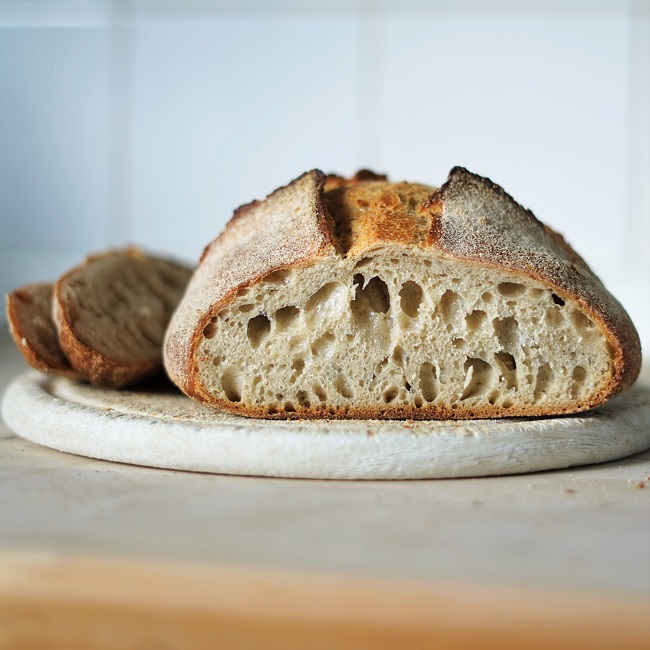
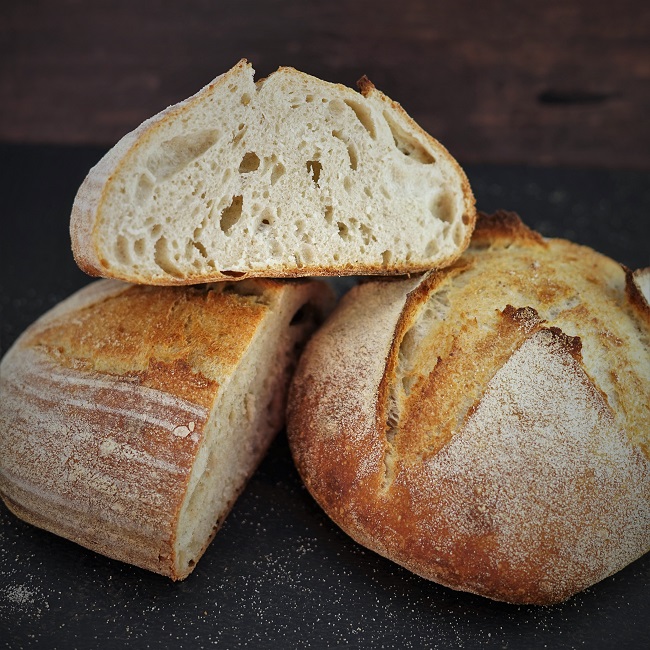
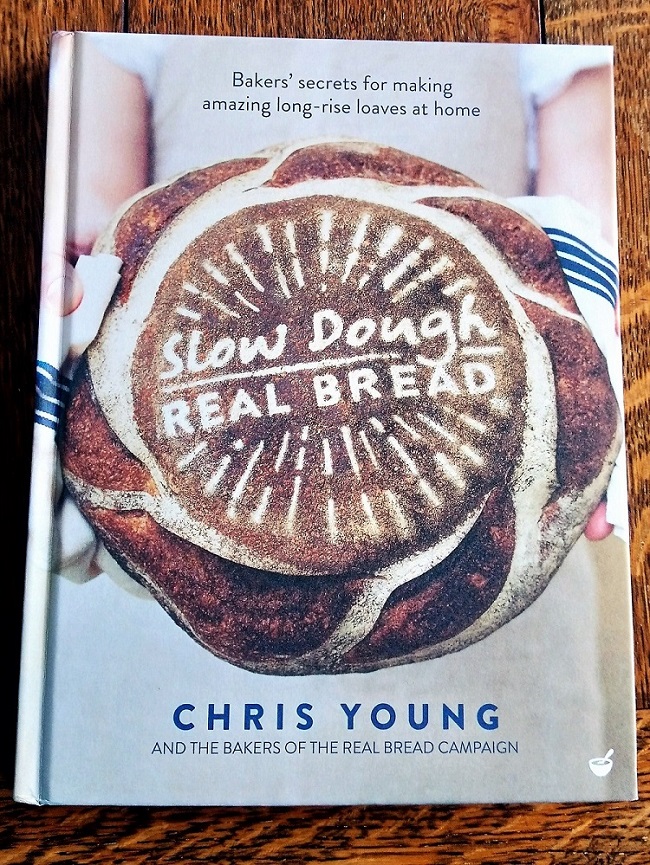
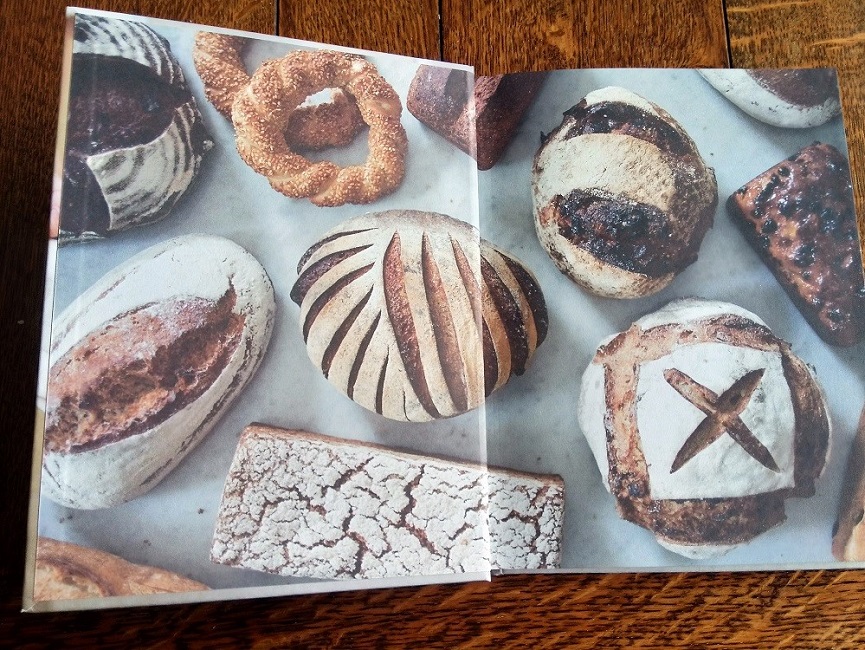
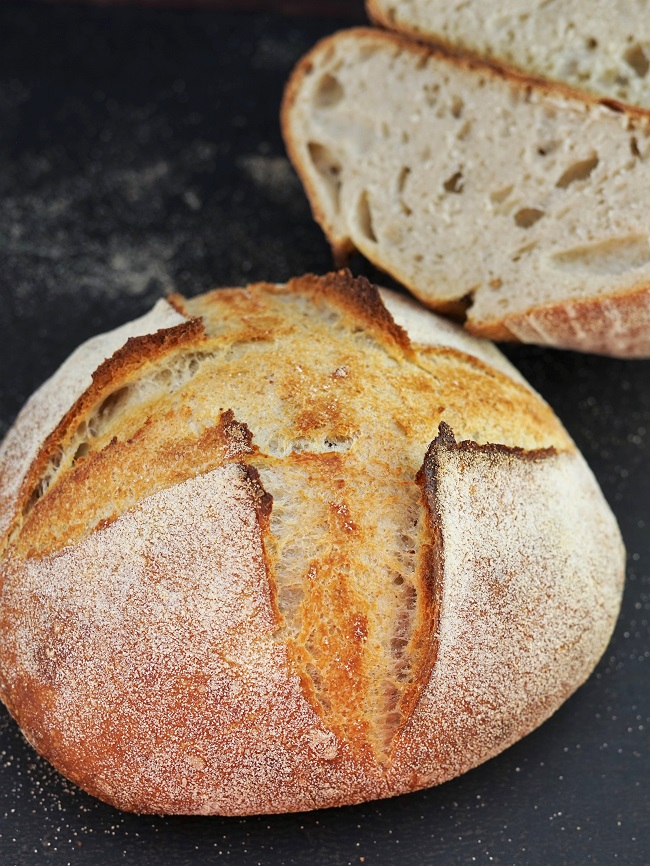


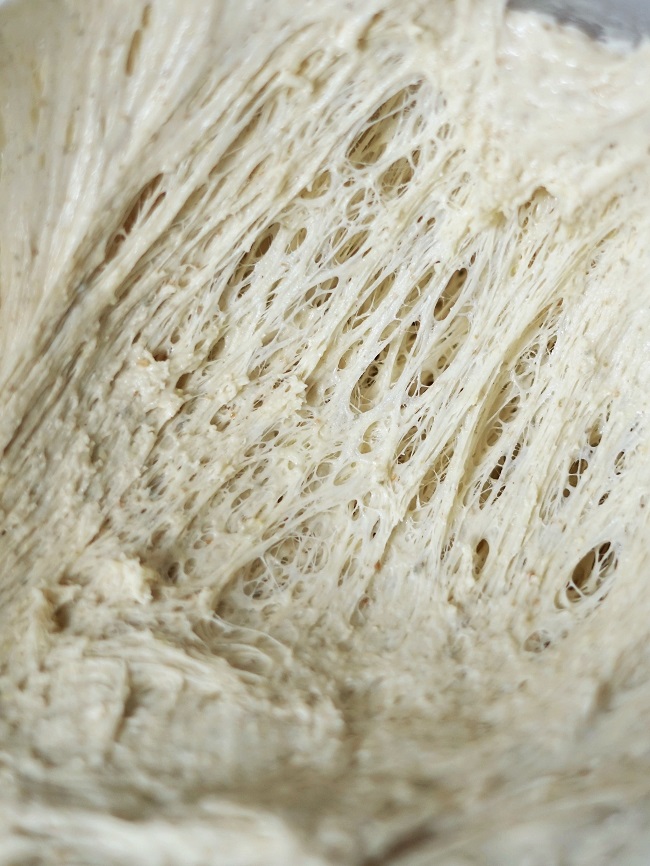

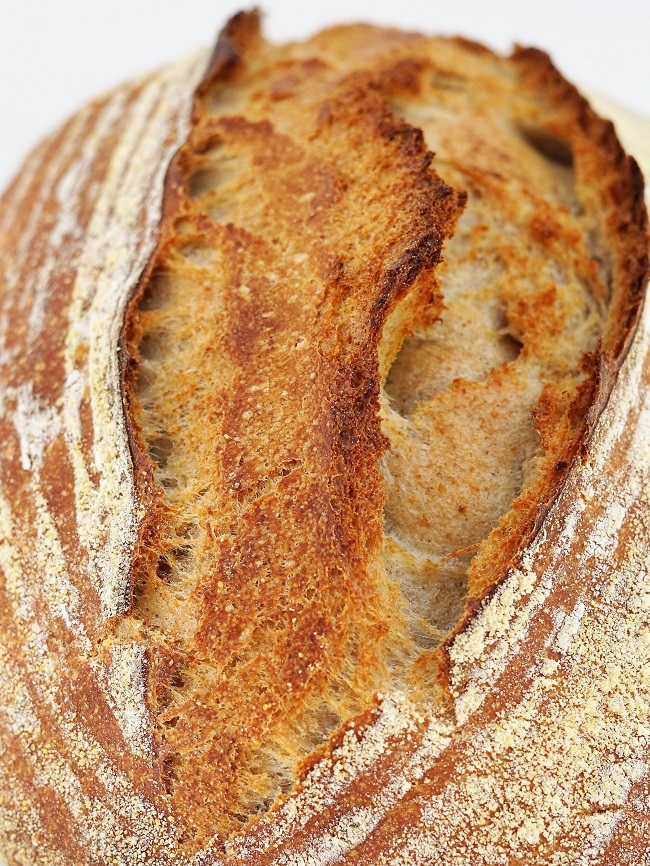

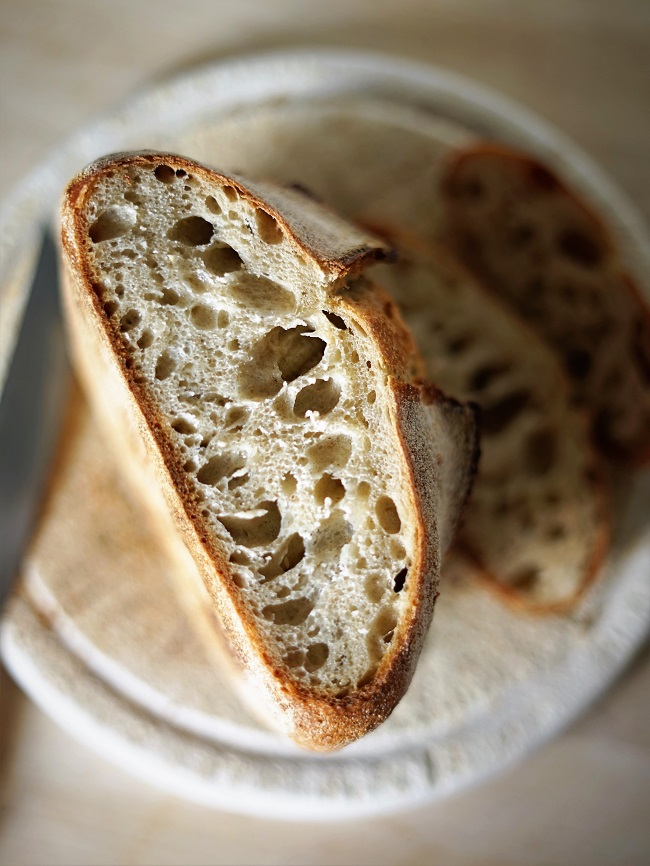
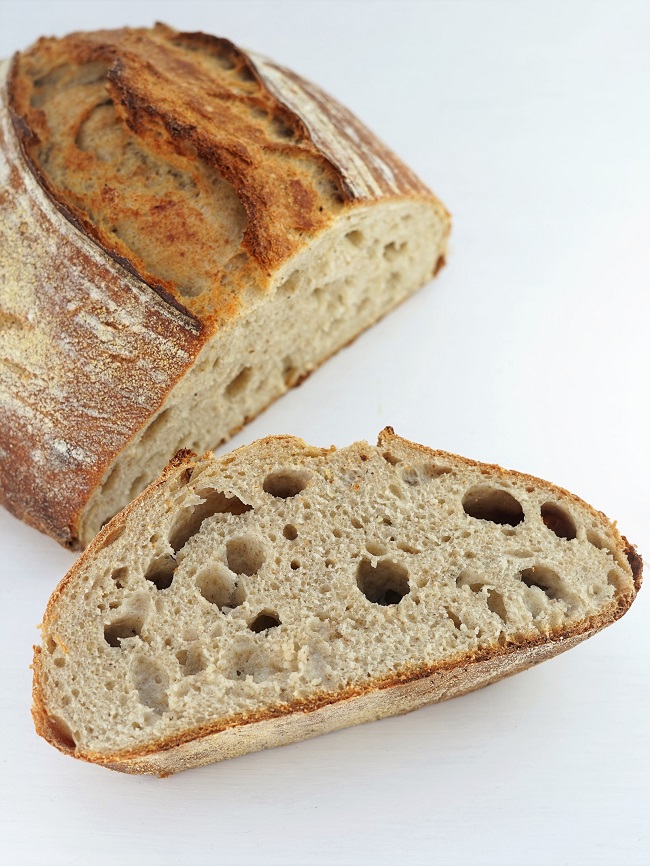
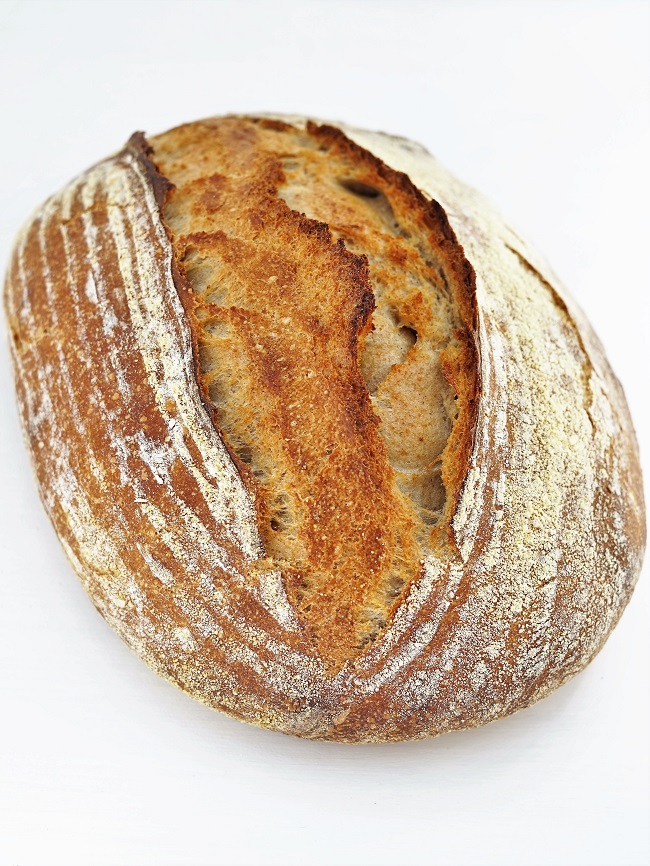


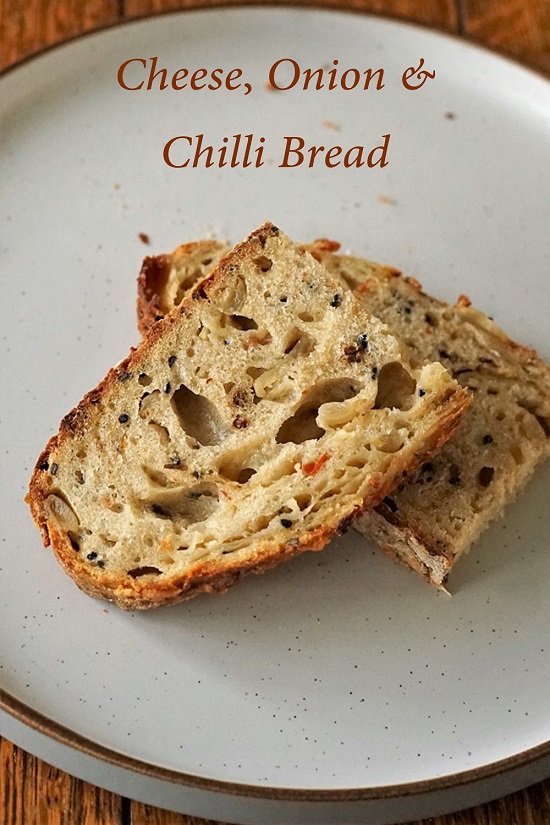
I have made this multiple times now, and I love this recipe! The bread is light, fluffy, and still undoubtedly a rustic sourdough loaf. Great bread!
Thank you for your wonderful feedback on one of my favourite breads!
This was incredibly good! I wasn’t sure if you salted the potatoes when cooking (which I would normally do if I were making mashed potatoes) but decided that it would make it difficult to estimate the amount of salt added, so cooked the potatoes without salt. Mixed the starter, potatoes and potato water first and then added the flours and 12 g of salt. Did 3 stretch and pulls about 45 minutes apart at the beginning. Let it rise 10 hours on the counter then did the second rise overnight in the fridge. Baked a single loaf in a Dutch Oven. I turned down the heat as instructed but left the loaf in the pan rather than putting the bread directly on the rack (not intentionally, I just missed that instruction!). It turned out beautifully!!
Thank you so much for your lovely, detailed comments and 5-star rating! So pleased the bread turned out beautifully.
I mixed per instructions but my dough was very dry so I added kefir until I had a wet dough. It was ready 13hrs later and followed instructions until I baked. I did have to use flour to handle wet dough and shape, just on outside.
I wish I could post the beautiful loaf that came out of the oven and it smells divine!
Hope it tastes as good as it smells, Kerry!
I have to make this recipe as I have never made potato bread before. I have been making Sourdough a couple of months and normally use a small amount of starter as I live in a warm climate. May I ask what your ambient temperature is when allowing the overnight rise? (12-16 hours) I am still learning what the dough should be like to be ready without over fermenting so using 100grams of starter is a bit scary.. I usually use 25grams and let it bulk ferment 11-13 hours at 74F When temperature was 68F or 69F I could use 50grams.. Thank you!
Hi Kerry, thanks for your interest in my recipe.
If you’re more comfortable using less starter than go ahead. For most of my breads I use 60 grams but used extra here to counteract any heaviness from the potato.
Here in the UK the overnight temperature in my unheated kitchen probably ranges between 16C (60F) – 18C (64F) so considerably colder than yours! However, you can do the overnight rise (or part of it) in the fridge which might be a good idea in your case. I would just experiment and see what works for you.
If you do make this recipe, I’d love to know how it went and how you adapted it to your conditions.
I do not have a scales, so I make sourdough bread using volume measurements. Can you provide the volume measurements of the ingredients in this recipe? Thanks!
Sorry, I don’t do volume measurements as there is too much room for error and really only recommend scales.
However, if you search online I’m sure you’ll find conversion information for the ingredients.
Hope you enjoy the recipe if you try it 🙂
I’ve been a sourdough baker for a couple of years but had never come across this method of adding potato so had to give it a go straight away! So happy with the result; a beautiful open crumb and a wonderful crunchy crust … a perfect loaf! They also say the potato makes it sweeter when toasted. At the time of writing this review I’ve only enjoyed it fresh but have no doubt it won’t disappoint there too! Thanks for sharing the recipe.
Thank you for your lovely feedback, Anna! Glad you enjoyed my recipe 😊
Hi, how do you make your starter please as I am new to making my own sour dough potato bread.
Hi Bronwyn,
I don’t have a recipe for my starter on the blog. I made mine over 10 years ago: many years before I started my blog!
But I recommend trying this simple, sensible version from the Real Bread Campaign: https://www.sustainweb.org/realbread/bake/jan19_simple_sourdough_starter/
Good luck!
This is a great “lazy” bread recipie. Tme does most of the work for you. Perfect for when you have a busy schedule.
Most bread recipies I find online don’t call for enough water. This one is perfect. I used 12.7% protein bread flour. Came out great!
Thank you for your great feedback, Ian. Very pleased the recipe worked so well for you!
I’m waiting for my sourdough to finish cooking in the oven! It’s hard not to peek. This is my third attempt and by far the easiest recipe. I did a little bread pulling & stretching, only because I couldn’t help myself!! I’ll let you know how it went.
This is the best, simplest sourdough recipe I’ve made during the dark days of the pandemic, thank you! The whole family now call me an “usta” (master) bread baker. I substitute whole wheat flour for the rye, since rye isn’t low Fodmap, and use regular flour because that’s what I can get easily here in Turkey. Still comes out great! I also throw in some unnecessary slap and tickle (folding it four or five times) after letting the dough rest an hour after mixing) but that’s only because it’s fun!
Thank you for your lovely feedback Lindy, this is one of my abssolute favourite breads too!
Nothing wrong with a bit of slap and tickle either if that’s your thing 😄
My first potato bread, and also my first from one of your recipes. Terrific bread, with a great chew , and crust. I used about 60% of the suggested salt, and that worked fine for me. Your instructions were faultless. Now: onto the next recipe.
Thanks
Thank you for your lovely comments, Richard! This is one of my favourite breads in terms of both flavour and texture.
The amount of salt in bread is certainly a matter of personal taste: when my partner makes bread I often say, only half joking, ‘did you forget the salt?’ 😄. But that’s how he prefers it.
I hope you enjoy my other recipes and many thanks for taking the time to give your feedbak.
Easily the best sourdough I’ve ever made – many thanks for the recipe. I’ve never used the Dutch pot method before and it made a huge difference.
That’s fantastic to hear Richard!
Many thanks for taking the time to comment and rate the recipe.
Hi Lynne,
I am really happy to find your Sourdough Potato Bread recipe. Can I ask what sort of potatoes you recommend? Many recipes I see suggest waxy ones.
I am also interested that you retard the dough overnight without stretching or folding at all. I am used to making sourdough and alway bulk proof, stretching and folding every 30mins, before initial preshape and final shape into banetton and retarding in fridge overnight. Can I also ask have you tried making the dough with raw grated potato and if so how has you success rate been?
I very much look forward to trying your recipe and plan to do so tomorrow. Fingers crossed you will see my message before then.
Thanks again for sharing and happy baking
Jim
Hi Jim,
Many thanks for your interest in this recipe.
Strictly speaking, as this recipe calls for mashed potato, I’d go for a floury one as in my experience they are usually better for mashing than waxy.
I haven’t made this particular bread with raw grated potato although I have with yeasted breads in the past and they have worked well too.
To be honest, the amount of potato is relatively small so I doubt the type would make a huge difference to the end result, nor possibly whether they’re raw or cooked.
As to the lack of stretching and folding, the idea of a wetter dough with a longer rise is that this develops the gluten so they aren’t strictly necessary. If you’re more comfortable doing so though, I’m sure it won’t do any harm. Obviously though, with a dough perhaps wetter than you’re used to, it might be a little trickier!
However you decide to proceed, do let me know how you get on, Jim.
Many thanks for the reply Lynne. Hopefully I will make it tomorrow and let you know how I get on.
Best
Jim
No problem, Jim.
Hi
Thanks for the sourdough potato recipie. I’ve made my own bread with good results and I’d like to try this one. I don’t have a dutch oven or cast iron pot. can I use a substitute?
Regards Carol.
Hi Carol,
I’ve heard people get good results using stainless steel pots, so long as they and their lids can withstand the high temperatures.
If you don’t have any suitable pot, then I’d use whatever you normally do for bread making e.g. on a baking sheet. If baking on a sheet, you may wish to reduce the liquid content a little so the dough doesn’t spread too much when you flip it onto the sheet.
Do be aware though that deviations from the recipe method or ingredients may not give you the same result.
Good luck and do let me know how it goes if you decide to give it a go!